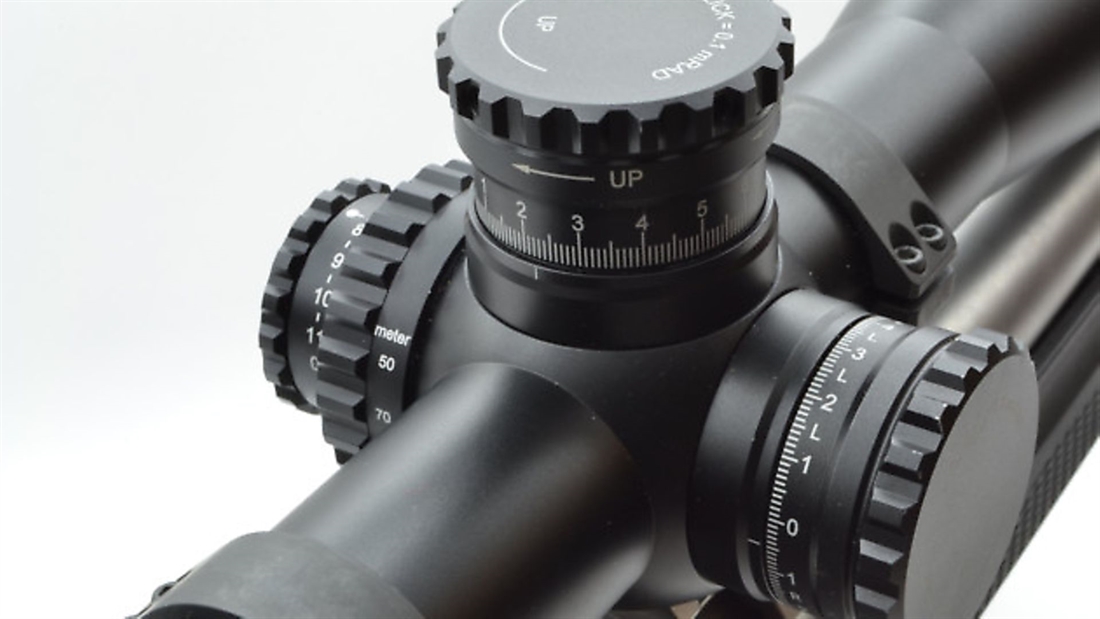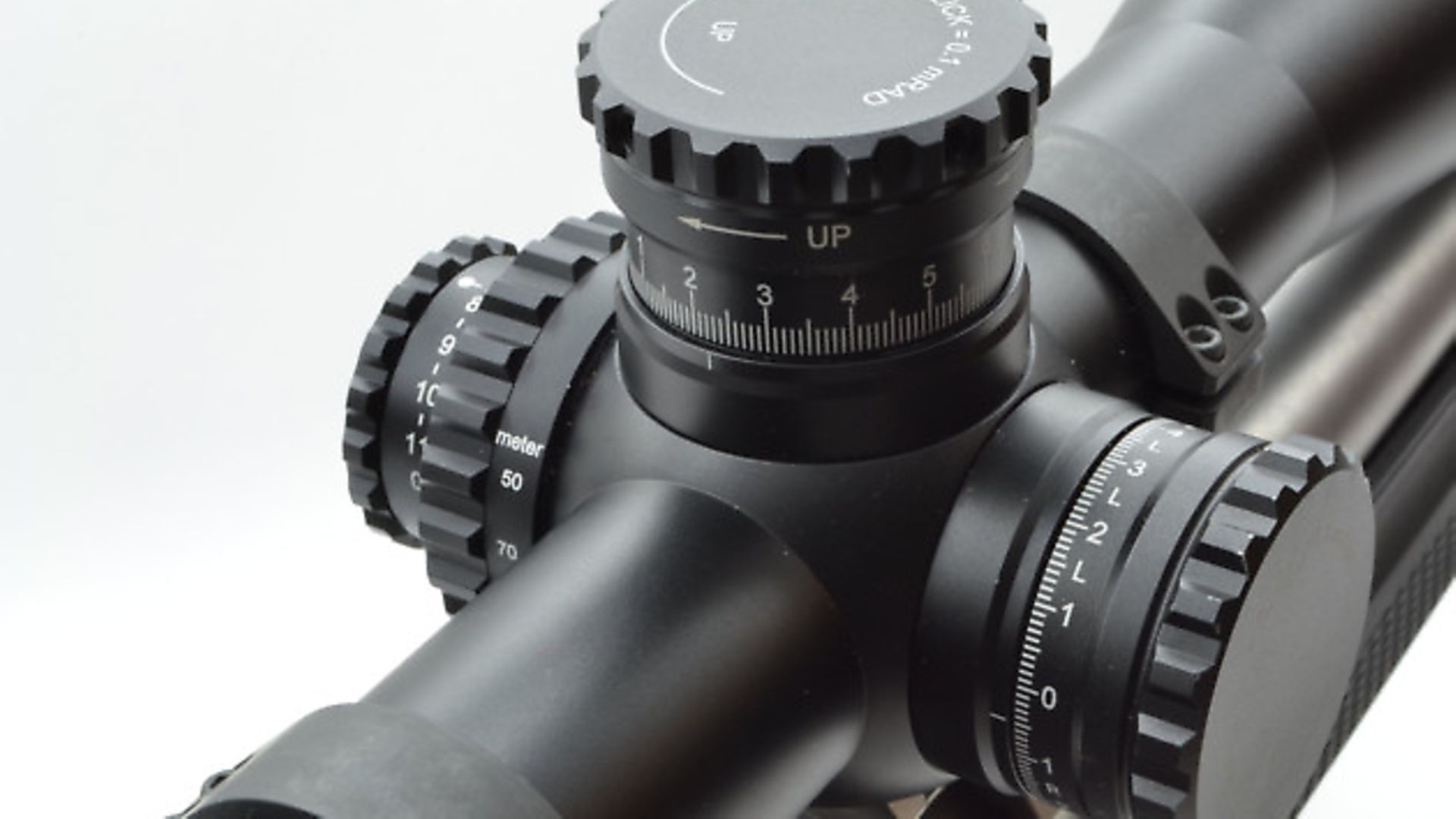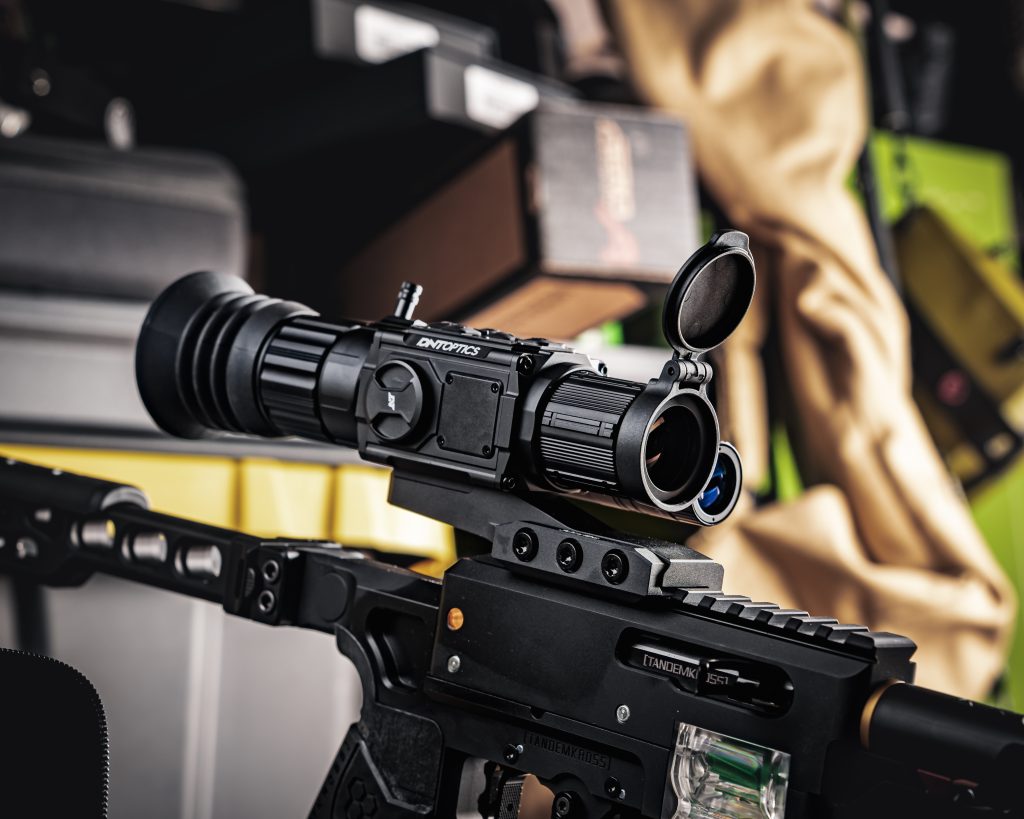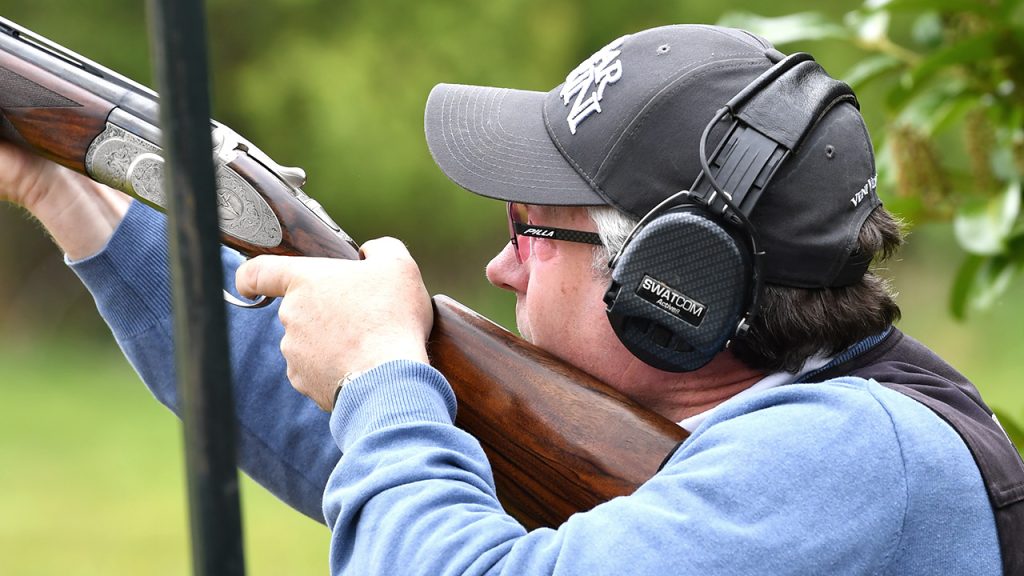Steiner MX5i 5-25X56 – in depth review and test

An in depth test and review of this tough Steiner MX5i 5-25X56 riflescope, from the ever-thorough Chris Parkin
For
Bright image quality with nice colours even in dusky conditions
Excellent lens caps supplied
Precise adjustments that performed a perfect box test
Loved the innovative DuoScale ‘curtain’ – no mistakes possible!
Against
I prefer reticles with half and full mil lines to dots as these obscure too much target and can confuse with bullet holes on paper
Clicks on the turrets are closely spaced with 150 per turn – easy to overrun if careless
Verdict
Steiner are very keen to promote the toughness and durability of their products from military environments, and claims like that are what put Schmidt & Bender where they are. I found the scope simple and intuitive to use with precise build quality and a great image, but magnification was extremely stiff to adjust. I would prefer the finer etched MSR reticle as the mil-dot seems a little old fashioned now.
Specifications
Steiner MX5i 5-25×56
Magnification 5-25x
Objective Lens Diameter 56 mm
Tube Diameter 34 mm
Focal Plane 1st
Field of View @ 100 m. 23.6 – 4.6
Eye Relief 89-116mm
Exit Pupil 9.8-2.2mm
Length 422mm
Weight 1,032gr
Diopter Adjustment Range +2 to -3
Reticle G2B Mil-Dot or MSR
Illumination Control Rotary Control with Intermediate on/off
Elevation Adjustment Knob DuoScale™ / Resettable Zero
Wind/Elevation Click Value 1 cm (0.1 mRad)
Windage Range @100 m 60 cm (6 mils)
Elevation Range @100 m 260 cm (26 mils)
Parallax/Focus Side Focus
Parallax/Focus Range 50m. to Infinity
Nitrogen Filled Yes
Lens Cap Yes
Waterproof/Fogproof Submersible to 10m.
Battery CR2450
Special Features Adjustment Knobs 100% Sealed
Warranty Heritage™ Warranty
Price
RRP £2,350
Contact
GMK 01489 579999
www.gmk.co.uk
IN DEPTH REVIEW
The market for 5-25×56 first focal plane riflescopes is tough. It is a specification built upon military pedigree and there are certain ‘rules’ that must be followed. Toughness, durability, speedy tactile adjustment, illuminated reticles and a 34mm tube characterise the breed where weight is not such an issue and size, although large, is small in proportion to the rifles to which they are likely to be fitted. Name and reputation are critical.
Schmidt & Bender’s PMII was the scope that started this trend and, over the years, I have tried wannabes from about every manufacturer there is, but as soon as you put ‘5-25×56’ on the box, you are laying down a gauntlet in a very particular argument to my mind – very few measure up!
My first impression of the Steiner MX5i as it was lifted from the box and fitted to a set of 34mm mounts was a general feeling of deluxe standards. Steiner also makes a TX5i where ‘tactical’ rather than ‘military’ attributes are favoured with the main on-paper difference being far broader windage adjustment on the TX5i. I found it hard to ignore the price, as this is a niche for which some manufacturers value themselves on echoes of military myth and machismo, so at £2,350 I thought the Steiner had a fair chance of serious consideration. ‘M’ does stand for ‘military’, with associated promised durability on .338 Lapua and .50 BMG rifles.
Turret design is the first port of call for me. The Steiner’s dials are a generous 42mm in diameter and all black with minimalist white demarcation for 150 clicks per turn. Everything is hard anodised to matt perfection with aggressive knurling to aid grip, with or without gloves, yet it retains the delicate feel needed to discern those 150 increments per turn. Each click is 1cm at 100m, or 0.1 MRAD, and agrees perfectly in adjustment with the first focal plane mil reticle, which I tested extensively at 100m on paper, dialling deliberate adjustments to steer bullets around the target and back to zero because I wanted to prove it. I haven’t had much time with Steiners to gain personal trust in their very reputable name, and I came away impressed.
Given the need for masses of mechanical adjustment on scopes such as these, the need to correctly set up the elevation dial is crucial. Steiner’s approach was quite new to me. There are 15 mils per turn and as you get to ‘mil 15’, the turret’s marking collar rises like a stage curtain to reveal new markings, now from 15 to 26 mils. This is a neat way of doing it and, in daylight, is very accurate and would be difficult to make mistakes with; but in low light? With gloved fingertip you might feel the ‘curtain’ go up, but would you be sure? Still, it is neat, and visually no mistakes can be made with a zero stop present and the outer dials resettable to zero with two nice simple Allen key grub screws. No clicking noises run in the background when they are slack, which assures you that you are rotating just the dials, not adjusting the internal mechanics, and I find this preferable to scopes that still click whether ‘floating the dials’ or not. Parallax (40m to infinity) adjustment sits to the left of the 34mm tube’s saddle with the illumination control central to it. Intensity runs from 0-11 and back to 0, with ‘off’ settings between each increment for speedy intuitive adjustment. I don’t know why some manufacturers think we need more complication. Unlike sporting scopes, these do not have angular auto on/off functions, but will turn auto off to save the life of the CR2450 battery. The parallax dial was large in diameter for a hand-sized grip and quite stiff to turn, but had no backlash and enabled a sharp focus to be attained. Magnification control looks like aluminium knurling, but is a very hard rubberised compound and, again, very stiff to turn, yet super smooth. I would like to assume this will bed in a little because it required a very firm grip to twist and there isn’t much space for your fingertips and knuckles to turn around the ocular body without tearing skin off on the bolt handle/shroud below it.
All the usual trade names, promises of glass quality and fantastical lens coatings were provided, with assurances of 10m submersion tightness, inert gas fill and a solid warranty. Unsurprisingly, being a German optic, the image quality was excellent. No tunnelling in the field of view appeared when magnification was lowered to five. A fast-focus eyepiece is present and excellent flip-up eye cups are fitted that fold flat over the objective and ocular bodies. They seemed durable throughout the test and certainly didn’t crack in conditions that a others would have. Competitors should take note here as they are far neater than bulky Tenebraex covers. The reticle’s centre 5 mils illuminate so you can see it easily at low magnification, but it is nicely weighted to leave a clear picture and still aim onto smaller targets when wound up to 25x. Being set in first focal plane, it gets bigger as you wind up the zoom, but all indicated sub-tensions remain precisely relative to the turret’s adjustments. You can see a 1.5 mil miss, aim off by 1.5 mils or dial 1.5 mils and all will agree, regardless of magnification. Windage is marked 6 mils left and right of zero on the right-hand turret, with 26 mils of total internal elevation travel available up top, but don’t forget, some of this will more than likely be used when initially zeroing the gun and, for longer ranges, an inclined scope mount is usually preferable. Zeroed on the Tikka T3X CTR with a zero inclination Picatinny rail, I had 14 mils of upward travel remaining which would have theoretically allowed shots aimed out to about 1,100m, far beyond the likely engagement range of that calibre. As well as individual mil dots, each half mil is hash-marked up to 5 mils, and then the heavier outer stadia each have a further demarcation 10 mils from centre.
Reticles are very personal choices – I prefer the lines to dots and would have chosen the optional etched MSR reticle were the scope to be for my own use. I think the Steiner is a welcome addition to the 5-25×56 FFP marketplace and worth a look for rifles intended for serious long-range shooting, large calibres, and especially steel plate and tactical shoots where multiple rapid adjustments are required with accurate fast aim offs facilitated.
Related Articles
Get the latest news delivered direct to your door
Subscribe to Rifle Shooter
Elevate your shooting experience with a subscription to Rifle Shooter magazine, the UK’s premier publication for dedicated rifle enthusiasts.
Whether you’re a seasoned shot or new to the sport, Rifle Shooter delivers expert insights, in-depth gear reviews and invaluable techniques to enhance your skills. Each bi-monthly issue brings you the latest in deer stalking, foxing, long-range shooting, and international hunting adventures, all crafted by leading experts from Britain and around the world.
By subscribing, you’ll not only save on the retail price but also gain exclusive access to £2 million Public Liability Insurance, covering recreational and professional use of shotguns, rifles, and airguns.
Don’t miss out on the opportunity to join a community of passionate shooters and stay at the forefront of rifle technology and technique.





